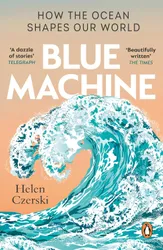By the same author as Storm in a Teacup, Helen Czerski, this book explores the nature of our oceans, and uses the analogy of earth’s oceans operating like a giant machine, as currents and tides move water around the planet. We learn about the different oceans, how they are connected, and the impact they have on our planet as a whole.
I was interested to learn that the ocean isn’t uniformly mixed, and that there tend to be different layers of temperature and salinity in the ocean. Sunlight only penetrates a short way into the ocean below the surface, so this represents another layer near the surface, in which photosynthesising organisms can live. The layers discussed support different types of life, and the book covers some of the organisms that make their living either at particular depths, or by moving between layers. There are also creatures that take advantage of ocean currents to move around the planet to feed and reproduce, such as turtles and eels.
We learn a little bit about the causes of ocean currents and winds, and how these have been exploited by human navigators. One of the recurring themes of the book is the author’s experiences in Hawaiian outrigger canoes, and how this has helped to give her a more visceral connection to the oceans that she studies. There is also a fascinating section about the sharing and regaining of navigational knowledge by people from the pacific islands, when this was in danger of becoming lost.
There is a section towards the end of the book about humanity’s impact on the earth’s oceans, and naturally this is a bit depressing. As well as climate change from the burning of fossil fuels, we have generally viewed the ocean as a dumping ground for things we don’t want. However, none of the major problems seem unsolvable if we work together, and the book does try to strike a hopeful tone. One example of humans working together successfully on environmental issues is the worldwide ban on CFCs, when it became clear that these were damaging the ozone layer. Speaking of CFCs, the book talks about these in the context of the damaging inventions of Thomas Midgley Jr, who also had the idea to put lead in petrol.
One of the author’s bugbears is the statement, often repeated, that we know more about the surface of the moon than earth’s oceans. Coincidentally, during the process of reading this book I visited an aquarium where this statement was displayed on one of the information boards. Czerski takes particular issue with this statement as being completely untrue. She makes the case that there is not much to know about the surface of the moon, while we already know a lot more about our oceans (while of course recognising that there is much more to find out). So I will join the fight against this banal and misleading statement!
Like Storm in a Teacup, there are some great stories and descriptions of Czerski’s own ocean-going trips to collect data for scientific research. I particularly liked the descriptions of some of the equipment used to sample the ocean. There aren’t many images in this book, but I don’t particularly feel it needs any more because the descriptions are so good.
I found this book really enjoyable and full of interesting information. There are sections of beautiful and evocative writing, and I enjoyed the first-hand accounts of doing ocean science while learning a lot about earth’s oceans.
